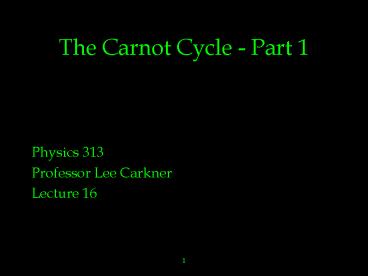The Carnot Cycle Part 1
1 / 16
Title: The Carnot Cycle Part 1
1
The Carnot Cycle - Part 1
- Physics 313
- Professor Lee Carkner
- Lecture 16
2
Reversibility
- Consider a system where processes do work or
exchange heat - If the same amount heat and work are done with
the reverse sign and no other changes in any
other system takes place the process is
reversible - A reversible process must not change any other
system - No real process is reversible
3
Mechanical Reversibility
- Most processes that convert work into heat are
irreversible - In order to reverse them you would have to
completely convert heat into work - Violates Kelvin-Planck statement
- Virtually every process converts some work into
heat
4
Isothermal Work
- Work done in contact with a reservoir
- Heat is produced but no temperature change
- To reverse must convert heat completely into work
- Example
- Friction, stirring, compression of a system in a
large body of water
5
Adiabatic Work
- Work done on insulated systems
- Heat and temperature changes are produced
- To reverse, must restore temperature by removing
heat and converting to work - Example
- Friction, stirring or compression of insulated
systems
6
Dissipation
- Converting work into internal energy is known as
dissipation - Dissipative effects produce external mechanical
irreversibility - Can reduce but can never eliminate dissipative
effects - Any real machine involves dissipation and is thus
irreversible
7
Thermal Irreversibility
- Heat flowing from hotter to cooler systems
- Changes internal energy
- Need to have heat flow from cool to hot
- violates Clausius statement
- Example
- melting ice
- can re-freeze, but that requires work
8
Perpetual Motion Machines
9
Perpetual Motion
- Three kinds of perpetual motion
- 1st kind
- Machine that creates energy
- violates 1st law
- 2nd kind
- Machine that converts heat completely into work
- violates 2nd law
- 3rd kind
- Machine with no dissipation
- violates 2nd law
10
Ideal and Real Systems
- Real systems are not reversible
- not quasi-static
- dissipative
- Can approximate an ideal system with a heat
reservoir - Can also approach reversibility by reducing
dissipation
11
Carnot Cycle
- A Carnot engine is a device that operates between
two reservoirs (at high and low T) with adiabatic
and isothermal processes - An adiabatic rise from TL to TH
- An isothermal addition of heat QH
- An adiabatic fall from TH to TL
- An isothermal subtraction of heat QL
- Engine Applet
12
Carnot Info
- Carnot cycles can operate with many different
systems - gas, liquid-vapor, paramagnetism, battery
- Operates with only 2 reservoirs (only two
temperatures) - Cycle is reversible
- All other cycles involve heat transfers across
temperature changes and thus are irreversible
13
Carnot Refrigerator
- If you reverse a Carnot engine, you get a Carnot
refrigerator - Isothermal absorption of heat QL
- Adiabatic rise from TL to TH
- Isothermal subtraction of heat QH
- Adiabatic fall from TH to TL
- If the two reservoirs are the same, the heats and
work are the same from a Carnot refrigerator and
engine
14
Carnots Theorem
- The Carnot cycle is the most efficient cycle
operating between two reservoirs - Reversible processes are the most efficient
- The Carnot efficiency is the maximum efficiency
and engine can have - Carnot efficiency is an upper limit for any engine
15
Corollary
- All Carnot engines operating between the same two
reservoirs have the same efficiency - Efficiency only depends on the temperatures of
the reservoirs - Maximum efficiency of any engine depends only on
the temperatures of the reservoirs
16
Comparison with Other Engines
- In other engines heat exchange occurs at several
temperatures - For Carnot heat exchange occurs at max and min
temperatures of system - This makes heat transfer and thus work easier
- Can never achieve true reversibility due to
dissipation - Carnot efficiency is upper limit































